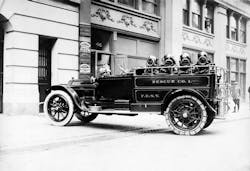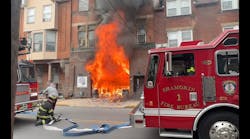LANCASTER, PA: MARCH 3, 1915 – Two destructive fires occurred in Lancaster County during the night. In Ephrata, sparks from a passing Reading Railroad engine ignited a huge, two-story, frame tobacco warehouse. Three hundred cases of tobacco and 325 empty cases were burned. The other fire was in a Quarryville feed warehouse. The cause of this blaze was not known.
BENNINGTON, VT: MARCH 4, 1915 – A fire started at about 2 P.M. in the Lafortune restaurant at North and Main streets. Box 48 was pulled and the fire department responded quickly. Firemen found a wooden partition in the rear of a gasoline stove ablaze. A line was stretched and the fire doused in a matter of minutes.
HASKELL, NJ: MARCH 6, 1915 – Five workers, one of them a boy, were killed by an explosion and fire in the DuPont powder company plant. The exploding gun cotton destroyed four one-story buildings. One worker was pulled from the river, but later died from his injuries. The blast also injured many others and put 1,500 people out of work.
GALVESTON, TX: MARCH 7, 1915 – A huge fire raced through waterfront sheds containing 4,800 bales of cotton. For a time, the intense fire threatened the entire waterfront. Firemen battled the blaze for many hours before it was declared under control. The loss was estimated at close to quarter-million dollars.
NEW ROCHELLE, NY: MARCH 13, 1915 – Women and children held back a grass fire that was threatening to ignite nearby homes. Armed with wet brooms, they batted the flames that had burned an acre of tall grass. The newly appointed fire chief, Benjamin Badeau, happened to drive by and called out the Olympia Fire Company. They arrived quickly and soon had the fire under control.
CAMBRIDGE, MA: MARCH 14, 1915 – Undergraduate students at Harvard University sprang into action when a fire was discovered in a building occupied by the Hasty Pudding Club, one of the school’s oldest social organizations. The fire had started outside and worked its way into the building and onto the stage. Students stretched a house line and directed the stream at the blazing stage. Investigators termed the fire suspicious in origin.
MORRISTOWN, NJ: MARCH 18, 1915 – A devastating fire tore through a house in Morris Plains. While the fire blazed on the upper floors, several young men attempted to save a large store of canned fruits the lady of the house had stored in the cellar. As the firemen moved in with hoses, the house suddenly collapsed into a huge pile of flaming wreckage. One of the young men was killed, but three others were able to get to windows where firemen, under the protection of a hose stream, pulled them to safety. They all suffered serious burns.
HOOSICK FALLS, NY: MARCH 20, 1915 – A heater is believed to have started a fire in a building in the Easton Thorpe block and spread to four blocks of business buildings. Mutual aid was requested from Bennington, Cambridge, North Adams and Troy. One of the first buildings lost was the post office, and flying embers from the original fire ignited several other buildings in town.
STAMFORD, CT: MARCH 30, 1915 – A plumber’s torch ignited a fire in the porch roof of a Norton Hill home. Driven by 50-mph winds, the flames spread quickly, destroying everything in their path, including one of the largest and most valuable collections of native American birds. The collection was to be sent to Yale University. Also lost in the flames was thousands of dollars worth of jewelry.
NEW YORK CITY: MARCH 8, 1915 – At 8 A.M., Captain John McElligott picked up the housewatch telephone in the quarters of Engine Company 33 on Great Jones Street in Manhattan and called the fire alarm dispatcher. With a few short words, he placed in service the newest unit in the FDNY, Rescue Company 1. The company, composed of eight firemen, a lieutenant and captain, was assigned a rebuilt 1914 Cadillac touring car (in photo) outfitted with smoke helmets, cutting torches, jacks, pulmotors (resuscitators) and various hand-tools. They were assigned to all second alarms south of 58th Street, all third alarms south of 125th Street, and could be special called anywhere in the city. Photo from Paul Hashagen Collection






